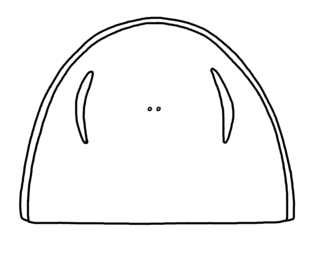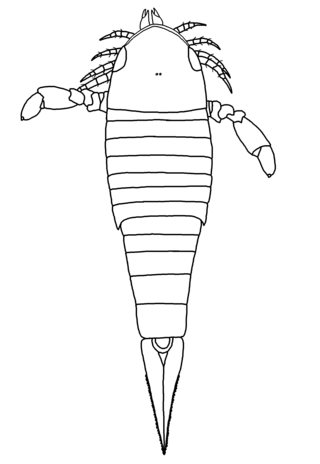
Eurypterids, often informally called sea scorpions, are a group of extinct arthropods that form the order Eurypterida. The earliest known eurypterids date to the Darriwilian stage of the Ordovician period 467.3 million years ago. The group is likely to have appeared first either during the Early Ordovician or Late Cambrian period. With approximately 250 species, the Eurypterida is the most diverse Paleozoic chelicerate order. Following their appearance during the Ordovician, eurypterids became major components of marine faunas during the Silurian, from which the majority of eurypterid species have been described. The Silurian genus Eurypterus accounts for more than 90% of all known eurypterid specimens. Though the group continued to diversify during the subsequent Devonian period, the eurypterids were heavily affected by the Late Devonian extinction event. They declined in numbers and diversity until becoming extinct during the Permian–Triassic extinction event 251.9 million years ago.

Eurypterus is an extinct genus of eurypterid, a group of organisms commonly called "sea scorpions". The genus lived during the Silurian period, from around 432 to 418 million years ago. Eurypterus is by far the most well-studied and well-known eurypterid. Eurypterus fossil specimens probably represent more than 95% of all known eurypterid specimens.

Slimonia is a genus of eurypterid, an extinct group of aquatic arthropods. Fossils of Slimonia have been discovered in deposits of Silurian age in South America and Europe. Classified as part of the family Slimonidae alongside the related Salteropterus, the genus contains three valid species, S. acuminata from Lesmahagow, Scotland, S. boliviana from Cochabamba, Bolivia and S. dubia from the Pentland Hills of Scotland and one dubious species, S. stylops, from Herefordshire, England. The generic name is derived from and honors Robert Slimon, a fossil collector and surgeon from Lesmahagow.

Hughmilleria is a genus of eurypterid, an extinct group of aquatic arthropods. Fossils of Hughmilleria have been discovered in deposits of the Silurian age in China and the United States. Classified as part of the basal family Hughmilleriidae, the genus contains three species, H. shawangunk from the eastern United States, H. socialis from Pittsford, New York, and H. wangi from Hunan, China. The genus is named in honor of the Scottish geologist Hugh Miller.

Alkenopterus is a genus of prehistoric eurypterid classified as part of the family Onychopterellidae. The genus contains two species, A. brevitelson and A. burglahrensis, both from the Devonian of Germany.

Bassipterus is a genus of eurypterid, an extinct group of aquatic arthropods. Bassipterus is classified as part of the family Adelophthalmidae, the only clade within the derived ("advanced") Adelophthalmoidea superfamily of eurypterids. Fossils of the single and type species, B. virgnicus, have been discovered in deposits of the Late Silurian age in West Virginia and Maryland, United States. The genus is named after Bass, where most of the fossils have been recovered.

Drepanopterus is an extinct genus of eurypterid and the only member of the family Drepanopteridae within the Mycteropoidea superfamily. There are currently three species assigned to the genus. The genus has historically included more species, with nine species having been associated with the genus Drepanopterus. Five of these have since been proven to be synonyms of pre-existing species, assigned to their own genera, or found to be based on insubstantial fossil data. The holotype of one species proved to be a lithic clast.

Nanahughmilleria is a genus of eurypterid, an extinct group of aquatic arthropods. Fossils of Nanahughmilleria have been discovered in deposits of Devonian and Silurian age in the United States, Norway, Russia, England and Scotland, and have been referred to several different species.

Pittsfordipterus is a genus of eurypterid, an extinct group of aquatic arthropods. Pittsfordipterus is classified as part of the family Adelophthalmidae, the only clade in the derived ("advanced") Adelophthalmoidea superfamily of eurypterids. Fossils of the single and type species, P. phelpsae, have been discovered in deposits of Silurian age in Pittsford, New York state. The genus is named after Pittsford, where the two only known specimens have been found.

Erettopterus is a genus of large predatory eurypterid, an extinct group of aquatic arthropods. Fossils of Erettopterus have been discovered in deposits ranging from Early Silurian to the Early Devonian, and have been referred to several different species. Fossils have been recovered from two continents; Europe and North America. The genus name is composed by the Ancient Greek words ἐρέττω (eréttō), which means "rower", and πτερόν (pterón), which means "wing", and therefore, "rower wing".

Adelophthalmus is a genus of eurypterid, an extinct group of aquatic arthropods. Fossils of Adelophthalmus have been discovered in deposits ranging in age from the Early Devonian to the Early Permian, which makes it the longest lived of all known eurypterid genera, with a total temporal range of over 120 million years. Adelopththalmus was the final genus of the Eurypterina suborder of eurypterids and consisted the only known genus of swimming eurypterids from the Middle Devonian until its extinction during the Permian, after which the few surviving eurypterids were all walking forms of the suborder Stylonurina.

Unionopterus is a genus of eurypterid, an extinct group of aquatic arthropods commonly known as "sea scorpions". Fossils have been registered from the Early Carboniferous period. The genus contains only one species, U. anastasiae, recovered from deposits of Tournaisian to Viséan stages in Kazakhstan. Known from one single specimen which was described in a publication of Russian language with poor illustrations, Unionopterus' affinities are extremely poorly known.

Pterygotioidea is a superfamily of eurypterids, an extinct group of aquatic arthropods. Pterygotioids were the most derived members of the infraorder Diploperculata and the sister group of the adelophthalmoid eurypterids. The group includes the basal and small hughmilleriids, the larger and specialized slimonids and the famous pterygotids which were equipped with robust and powerful cheliceral claws.

Adelophthalmidae is a family of eurypterids, an extinct group of aquatic arthropods. Adelophthalmidae is the only family classified as part of the superfamily Adelophthalmoidea, which in turn is classified within the infraorder Diploperculata in the suborder Eurypterina.

Hughmilleriidae is a family of eurypterids, an extinct group of aquatic arthropods. The hughmilleriids were the most basal members of the superfamily Pterygotioidea, in contrast with the more derived families Pterygotidae and Slimonidae. Despite their classification as pterygotioids, the hughmilleriids possessed several characteristics shared with other eurypterid groups, such as the lanceolate telson.

Herefordopterus is a genus of eurypterid, an extinct group of aquatic arthropods. Herefordopterus is classified as part of the family Hughmilleriidae, a basal family in the highly derived Pterygotioidea superfamily of eurypterids. Fossils of the single and type species, H. banksii, have been discovered in deposits of Silurian age in Herefordshire and Shropshire, England. The genus is named after Herefordshire, where most of the Herefordopterus fossils have been found. The specific epithet honors Richard Banks, who found several well-preserved specimens, including the first Herefordopterus fossils.

Wiedopterus is a genus of eurypterid, an extinct group of aquatic arthropods. The type and only species of Wiedopterus, W. noctua, is known from deposits of Early Devonian age in Germany. The generic name derives from the Wied river, which runs near the site of the initial discovery, and the species name, noctua, derives from Latin noctua (owl) which refers to the superficial resemblance of the carapace to an owl.

Eysyslopterus is a genus of eurypterid, an extinct group of aquatic arthropods. Eysyslopterus is classified as part of the family Adelophthalmidae, the only clade within the derived ("advanced") Adelophthalmoidea superfamily of eurypterids. One fossil of the single and type species, E. patteni, has been discovered in deposits of the Late Silurian period in Saaremaa, Estonia. The genus is named after Eysysla, the Viking name for Saaremaa, and opterus, a traditional suffix for the eurypterid genera, meaning "wing". The species name honors William Patten, an American biologist and zoologist who discovered the only known fossil of Eysyslopterus.

This timeline of eurypterid research is a chronologically ordered list of important fossil discoveries, controversies of interpretation, and taxonomic revisions of eurypterids, a group of extinct aquatic arthropods closely related to modern arachnids and horseshoe crabs that lived during the Paleozoic Era.

Pruemopterus is a genus of eurypterid, an extinct group of aquatic arthropods. The type and only species of Pruemopterus, P. salgadoi, is known only from a single fossil specimen, discovered in deposits of Early Devonian age in Germany. The generic name is derived from the Prüm river and the surrounding Prüm valley, which contains the finding place of the fossil, and the Greek πτερόν, referring to the eurypterid swimming paddles, and the species name honors the Brazilian photographer and photojournalist Sebastião Salgado.






















